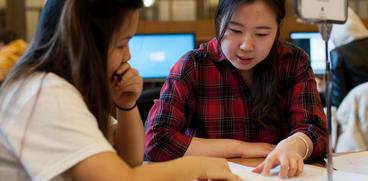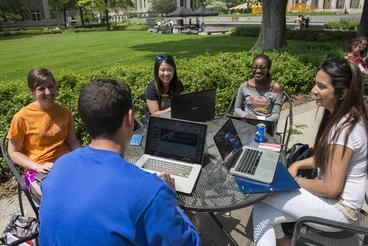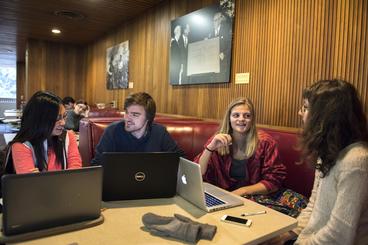
Benefits of Peer Response
Peer response workshops—activities in which peers read and comment on each other's drafts or ideas—enable students to get quick, direct, and timely feedback on their works-in-progress. While feedback is beneficial to the writer, research has also shown that peer response benefits the peer reader as well; the act of carefully reading another student’s work fosters the capacity to detect, diagnose, and improve one’s own writing. Peer response workshops may involve pairs or groups of students; might take place in class, outside class, or online; and can take anywhere from five minutes to over an hour. This resource page offers guidelines on ways to design and integrate peer response into courses. But, first, why use peer response in your classes?
- What do student writers gain from peer response?
- What do instructors gain from peer response?
- What are key considerations when using peer response workshops?
- When should peer response workshops occur?
- How can instructors structure peer response sessions?
- How long does a peer response workshop take?
- Potential challenges and ways to avoid them
What do student writers gain from peer response?
So many things! We list five below.
Opportunities to improve drafts before they are graded
When responses are given early enough, i.e., before drafts are in late stages, student writers are more likely to make substantial changes. Peers’ questions and comments can encourage a writer to deepen their approach to a subject and help them to anticipate reader questions in future writing projects. After student writers have struggled to complete an entire draft and set their ideas into a pattern of paragraphs, they may feel reticent about reorganizing, altering, or cutting from the work they consider almost finished.
An expanded idea of audience
Giving and getting feedback in a small group setting enables student writers to enlarge their concept of readership. Prior to this process, they may have written with the idea that their only reader was the course instructor. Hearing comments from a variety of readers with diverse, and perhaps contradictory, reactions makes writers realize they need to make deliberate choices in their writing. Because they can't please everyone, writers must revisit their original ideas of content and purpose in order to make revision decisions. In this way, workshopping can settle the responsibility of the writing and revision process back onto the shoulders of the writer. This is different from simply "making corrections" suggested by an instructor.
Practice in reading for revision
Reading and talking constructively to a group of peer writers about writing can strengthen students' independent ability to read for revision. In the peer workshop, students practice making constructive comments that are directed at writing rather than at writers, a distinction that can help depersonalize the process and increase the usefulness of feedback comments.
In addition, student writers are often relieved to get away from their own drafts in order to see how others are handling the assignment. Because they are much less emotionally invested in a peer's work, student writers are often able to see and articulate big-picture, global and substantive revisions more clearly. This in turn enables them to reflect on their own drafts.
Enhanced communication skills
Conversing with peers about their work can strengthen students' ability to articulate specific reactions and suggestions. We know that negotiating a revision suggestion with our own colleagues can require a tricky balance of tact and clarity. In successful student workshops, when it is made clear that "good job!" and "this is perfect as is!" will not be considered satisfactory remarks, students will develop communication skills that they'll find useful in future academic and professional endeavors.
Increased confidence
Students may start a course with an assumption that the writing done by classmates is much better than their own writing. When they see their peers' first drafts and realize that drafts don't have to be perfect and that those written by their peers look pretty similar to their own, they see that it is safe to loosen up and take risks in developing ideas.
What do instructors gain from peer response?
So many things! Here are a few benefits that enrich and extend beyond a single course.
Better written products and more time
Because students will have already been through one round of guided response and have subsequently revised their work, the drafts instructors see will, in all likelihood, be more thoroughly developed and organized. On a related note, peer response activities require that students prepare work in advance of deadlines and may then help them to avoid issues related to procrastination.
High levels of student engagement
Whether the workshops last five minutes or fifty, excitement is generated by participating in an activity involving simultaneous conversations about writing. Research conducted through the National Survey of Student Engagement and the Consortium for the Study of Writing in College affirms that when students are provided structured opportunities to talk about their written work before revising and submitting it, they are more engaged and their learning is deepened.
Valuable and actionable information about course assignments
While instructors always endeavor to make their assignment expectations clear, student peer response can provide an opportunity to confirm that students understand the elements and features of complex assignments.
Valuable and actionable information about student writing
When instructors assign and monitor peer response workshops in their classes, they are able to see emergent needs and trends and address them before students revise and submit. Peer response serves as a valuable tool for Just-in-Time Teaching, and it can often be combined with in-class writing workshops.
High evaluation ratings
Students recognize the value of effectively conducted peer workshops.
What are key considerations when using peer response workshops?
Successful peer workshops require careful pre-class planning.
Inadequate time, structure, or procedures and an absence of modeling can cause groups to flounder, wasting valuable class time.
Peer response requires time.
Whether instructors follow a five-minute pair model or a full-period group workshop model, in-class peer response takes time. Even if the peer response is conducted online, instructors will need to allot some class time to discuss the specific procedures for peer response workshops.
Peer workshops are student-centered.
In teacher-centered courses, the use of peer response will require a temporary shift. In order to succeed, the workshopping process should allow groups or pairs to work independently. This independence is reduced when instructors insert themselves into peer to peer discussions.
Peer response requires vulnerability.
Students, who are convinced they work most effectively on their own, may resist having to collaborate. Strong writers may have been praised for their self-sufficiency and thus feel capable of completing assignments on their own. These students may initially feel, therefore, that the peer workshop is not going to offer them anything they couldn't do better working solo. Once they participate in detailed workshop activity, however, these students often recognize the value of receiving diverse responses to their work and the extent to which providing feedback helps inform their own writing.
Students may not feel authorized to comment on others’ writing.
If students are accustomed to only receiving comments on their writing from instructors or experts, some students may not feel confident in assuming the role of commenting on another student’s writing. For some students, peer response may conjure concerns that their feedback will not be taken seriously by other classmates or that features of their own writing are still developing, so they aren’t in a position to tell others what to do.
Creating inclusive procedures for peer response that emphasize the value and importance of each student’s unique experience as readers can help build a more effective and rewarding peer response experience for all students. Similarly, well designed peer response activities will encourage students to respond as peers and fellow readers, rather than examiners or judges. The more experienced students are at writing in a particular genre or discipline, the more confident they may be on offering advice and guidance.
Peer response may carry negative baggage.
Inevitably, both students and instructors have had experience with poorly run peer groups. These experiences can, understandably, interfere with a willingness to re-engage in the process. Allowing students to voice their reservations early in the semester, when instructors give their rationale for using the technique, should help to clarify the ways in which upcoming workshops will differ from those of their past.
When should peer response workshops occur?
Educational research strongly supports the use of peer response at various stages of the writing process.
- During invention stages, peers can workshop their topics, research questions, and preliminary thesis statements
- During drafting stages, peers can workshop sections of their paper, such as introductions, methods, abstracts, results, use of sources, etc.
- During revision stages, students can workshop full drafts and prepare a revision memo.
- During editing and proofreading stages, peers can focus on specific stylistic, grammatical, and format issues.
- During the final submission stage, peers can draw on previous peer response sessions to inform their final draft that includes a cover letter and earlier drafts.
How can instructors structure peer response sessions?
During the course planning stage
- Include a description of the key stages of a draft, the rationale for peer response workshops, and an overview of the procedures and guidelines for peer response. The more integrated the peer response process is with the design of the course, the more likely students will view it as authentic and central to the learning.
- When creating course schedules, block out time for major peer response workshop(s) and time to discuss, model, and assess the process.
- Develop procedural guidelines for each assignment that is to involve peer response and put these guidelines into handouts and/or course resources. Depending on the time allotted and the context for peer response, procedures and guidelines can vary greatly.
In class
- Review the rationale for the peer response workshop, the procedures and the specific guidelines.
- When you are reviewing the guidelines in class, consider modelling a response using the guidelines and examples of student drafts. (Instructors will need to obtain student releases for these.)
- Provide opportunities for peer groups to debrief and assess.
How long does a peer response workshop take?
Peer response workshops can be as short as a 5-10 minute exchange of a brief piece of writing—such as a draft of a thesis statement, the use of a specific figure, graph, or chart, or a brief summary of a key source—or a longer session involving read-arounds of full drafts. Ideally, students will have experience giving and receiving feedback on writing before being asked to provide a lengthy and comprehensive review. Each of these examples below can be adapted to online formats as well through the use of Canvas-based tools.
5-10-Minute Workshops
Any of the following can be discussed in pairs:
- Key research questions
- Paper topics
- Theses, claims, or hypotheses
- Audience
- Tone or dissonance in select passage of writing
- Citation errors
20-Minute Workshops
Any of the following can be discussed in groups of four:
- Key research questions
- Paper topics
- Theses, claims, or hypotheses
- Sequences of ideas and organizational outlines
- Target audiences and rationales
- Supporting/countering arguments
20–40 Minute Workshops
Conduct a "read-around" on a part or entire short assignment. In a read-around, students bring two copies of a section of a draft—a proposal, a lead, an annotated bibliography, etc—or exchange them via a shared Google folder. All sets of copies are responded to by participants. If conducted onsite, students can pick one copy up, write brief comments, return it to the table, and take another draft at their own pace.
50-Minute Workshops (with out-of-class reading)
Full essay peer-group conferences, using specified peer response guidelines.
Potential challenges and ways to avoid them
Because most students have been engaged in peer response activities in their early school experience, they may have both positive memories of helpful comments and painful memories of sessions that were less helpful. Here's an overview of potential challenges with a peer response activity and how they might be avoided.
Challenge | Solution |
|---|---|
No response guidelines are provided.Peer response groups do not work automatically. If specific focus points are not provided in advance, students will likely feel that they are being asked to comment on how much they like the draft and/or how they feel about the person who wrote it. "Good Job!" or "Nice!" are often the most frequently voiced comments in these situations, augmented only by an occasional, "You might want to run spell check," or "You might want to put a period at the end of your third sentence." | Provide guidelines that give students concrete tasks.For example, guidelines might include aspects to look for ("Star what you take to be the thesis") and questions that guide their response ("Which of our established criteria does the thesis meet?") Make sure that there is a clear connection between the items in the guidelines and the criteria used to grade final drafts. Also, consider standardizing your procedure. You can outline the "steps" and designate time allotments for each on an overhead transparency or on the board. Read more about developing peer response protocols and procedures. |
Too many guidelines are provided.Overly-ambitious guideline sheets can overwhelm student readers and can result in their spending too much out-of-class time preparing for groups and too much in-class time talking about a single draft. This, in turn, can result in a group of writers who are unable to prioritize the points on their revision plans. | Start with a few target guidelines and then build on these during the semester.Early response activities may just include finding the thesis or doing a reverse outline of a few paragraphs, while later response activities might involve responding to the structure and development of the writing.Focusing on just a few key guidelines will allow students to become more comfortable and skilled with the process as more items are added. |
No models are provided.Again, students may never have seen an effective peer response workshop. Show them how it's done by providing a student draft and modeling comments of the sort you would like to see them making. | Build a stockpile of usable drafts.Create a standardized release form that can be signed by student authors at the conclusion of a course. The release form should indicate that all drafts will be redacted. |
Insufficient time is allotted.If students aren't given adequate time to read peer work with guidelines and discuss the draft and comments, they may be inclined to return to the "good job" comments. | Align the length of the workshop with its scope and purpose.Students should allow approximately 30 minutes to read and comment on each four-page draft. In class, if groups of four are workshopping full drafts, they should be allowed at least 50 minutes to discuss comments they've prepared for each peer draft--that gives each student a little over ten minutes to hear comments on their drafts. |
Students feel uncomfortable in their role of respondent.When the peer review guidelines require students to serve as a proxy grader for the instructor, then they are less likely to take an active role in the workshop. | Design descriptive and open-ended peer response guidelines rather than judgement-based guidelines.As John Bean points out, peer review prompts calling for descriptive response and reactions often elicit more time on task than judgmental feedback (297). See examples. |
The instructor is uncomfortable stepping back.A hovering instructor, or a variety of instructor interruptions, can damage the group's autonomy and may cause students to feel that the peer response process is merely an unnecessary hoop the instructor is forcing them to jump through before s/he gives the "real" feedback. | Model the process and then step away.As with any cooperative learning venture, interdependence needs to be built into the activity—students need to rely on each other to give formative feedback that will enable them to make necessary changes. It often takes one full go-round with the procedure you are initiating to allow them to see how well they can work in your class. |
The instructor doesn't believe peer response workshops are worthwhile.There are times when group activities do not live up to instructor expectations, and these unfavorable experiences can sour an instructor’s view of their benefits. Tinkering with the timing, procedures and guidelines of a peer response workshop will often make them more effective. | If you don’t think peer response workshops are worthwhile, then don’t use them in your course.However, if you are on the fence and willing to give peer response workshops a try, we’re happy to consult with you. |


